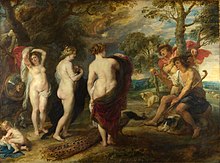George Kinnaird, 7th Lord Kinnaird
George Kinnaird, 7th Lord Kinnaird (1754–1805) was a Scottish aristocrat, virtuoso, and banker. He was a Scottish representative peer in 1787.[1]
Life[edit]
He was the son of Charles Kinnaird, 6th Lord Kinnaird and Barbara Johnstone, daughter of Sir James Johnstone, bart. He succeeded his father in 1767, and entered Pembroke College, Cambridge in 1769, graduating M.A. in 1771.[2]
Kinnaird was partner in the banking firm of Ransom, Morland and Hammersley of Pall Mall, London; the MP William Morland was one of the partners, as was Hugh Hammersley MP. Kinnaird fell out with the Prince of Wales, one of the bank's customers, who moved his business to Coutts & Co.[3][4] He was also chairman of the London Fire Office.[2]
With Morland, Kinnaird helped set up the Dundee New Bank in 1802.[5] Henry Boase as managing partner of the Pall Mall bank went to Dundee to reconstruct it, in 1804.[6]

Kinnaird was known as an art collector. The collection he founded was based on purchases from the Orleans Collection, dispersed in 1792, along with other works such as Parmigianino's Virgin and Child. The dealer Thomas Moore Slade imported Northern European works for Kinnaird, Hammersley and Morland. Kinnaird's collection was subsequently housed at, and named for, Rossie Priory; and was sold in 1948.[2][9][10]
In politics Kinnaird acted as treasurer to the Society of the Friends of the People, which he joined in 1792 with James Maitland, 8th Earl of Lauderdale and David Erskine, 11th Earl of Buchan.[11][12]
Kinnaird was elected a Fellow of the Royal Society in 1784.[13] He died on 11 October 1805, in Perth.[2]
Family[edit]
Kinnaird married Elizabeth, daughter of Griffin Ransom. He was succeeded by their second son Charles.[12] Their fifth son Douglas James William was an MP.[14] The other sons and the daughters were:[15]
- (1) George William Ransom, died 1779;
- (3) Henry, died 1784;
- (4) Edward Griffin, died 1803;
- (6) Frederick John Hay, died 1814;
and
- Eliza, married Edward Plunkett, 14th Baron Dunsany;
- Georgiana Mary Anne, married George Johnstone Hope;
- Laura Margaretta, died 1810;
- Amelia Barbara, died 1795.
Notes[edit]
- ^ George IV, King of Great Britain (1938). A. Aspinall (ed.). The Letters of King George IV 1812–1830. CUP Archive. p. 16 note 2. GGKEY:6ERQU9Q532Z. Retrieved 12 March 2013.
- ^ a b c d "Kinnaird, George, Baron (KNRT769G)". A Cambridge Alumni Database. University of Cambridge.
- ^ historyofparliamentonline.org, Morland, William (1739–1815), of 56 Pall Mall, Mdx. and Lee House, Kent.
- ^ historyofparliamentonline.org, Hammersley, Hugh (?1775–1840), of 76 Pall Mall, Mdx.
- ^ Richard Saville (1996). Bank of Scotland: A History, 1695–1995. Edinburgh University Press. p. 487. ISBN 978-0-7486-0757-0. Retrieved 12 March 2013.
- ^ Brown, Robert. "Boase, Henry". Oxford Dictionary of National Biography (online ed.). Oxford University Press. doi:10.1093/ref:odnb/2737. (Subscription or UK public library membership required.)
- ^ Leonard Robinson (2007). William Etty: The Life and Art. McFarland. p. 123. ISBN 978-0-7864-2531-0. Retrieved 12 March 2013.
- ^ William Buchanan (1824). Memoirs of painting: with a chronological history of the importation of pictures by the great masters into England since the French Revolution. Printed for R. Ackerman. p. 167. Retrieved 12 March 2013.
- ^ liverpoolmuseums.org.uk, The Rossie Priory collection.
- ^ William Buchanan (1824). Memoirs of painting: with a chronological history of the importation of pictures by the great masters into England since the French Revolution. Printed for R. Ackerman. pp. 17–8. Retrieved 12 March 2013.
- ^ George III and William Pitt. George III and William Pitt, 1788–1806. Stanford University Press. p. 215. ISBN 978-0-8047-0192-1. Retrieved 12 March 2013.
- ^ a b historyofparliamentonline.org, Kinnaird, Hon. Charles (1780–1826), of Rossie Priory, Perth.
- ^ Thomas Thomson (1812). History of the Royal Society: From Its Institution to the End of the Eighteenth Century. R. Baldwin. p. lxxvii. Retrieved 12 March 2013.
- ^ historyofparliamentonline.org, Kinnaird, Hon. Douglas James William (1788–1830), of Pall Mall, Mdx.
- ^ A Genealogical and Heraldic Dictionary of the Peerage and Baronetage of the British Empire. Henry Colburn. 1839. p. 601. Retrieved 12 March 2013.
